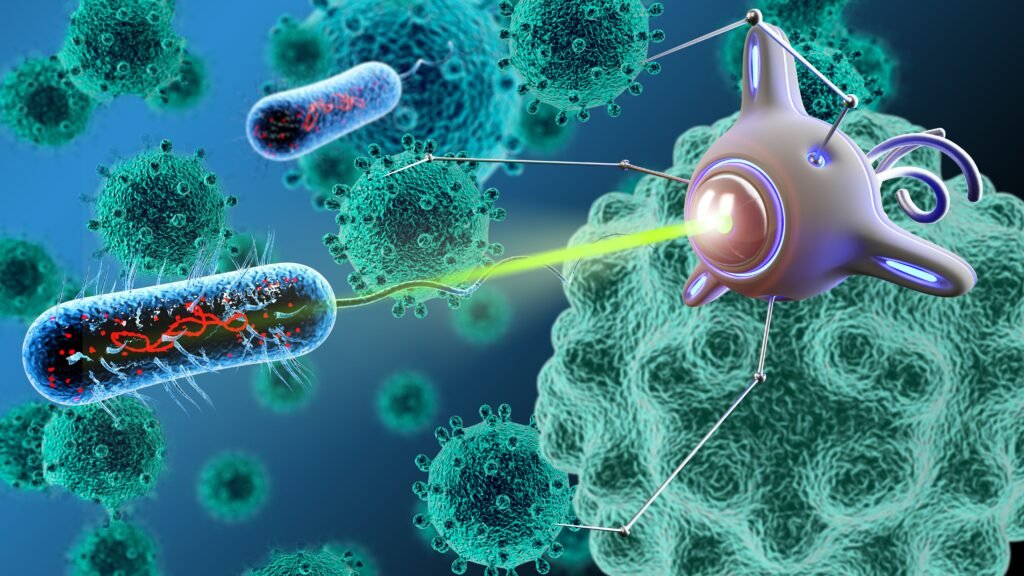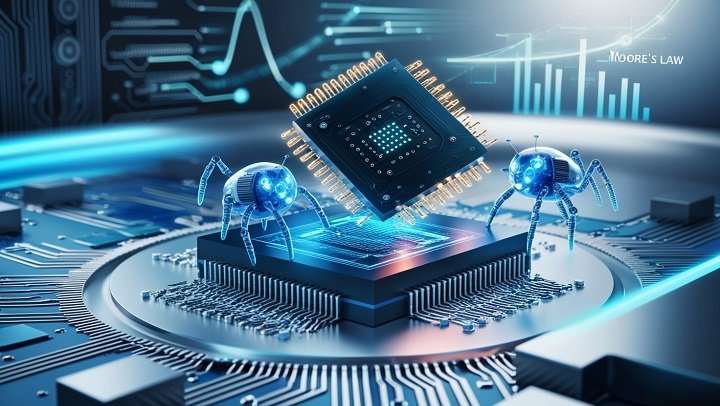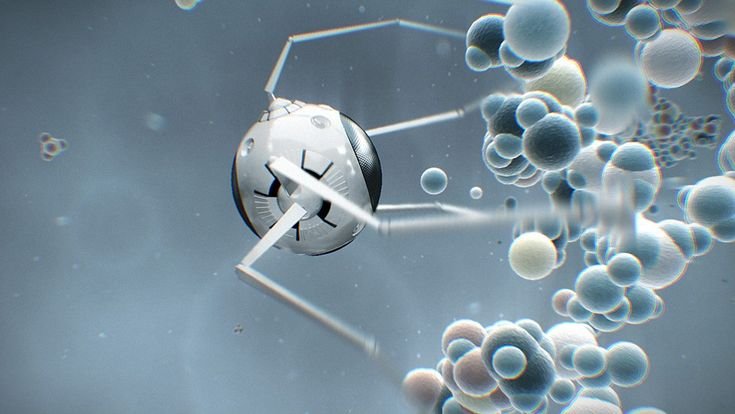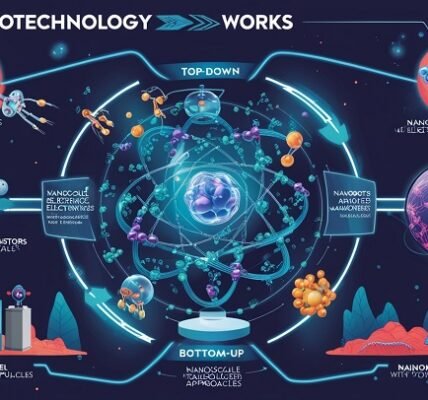- Homepage
- Latest Technology
- Moore’s Nanotechnology The Future of Miniaturized Technology
Moore’s Nanotechnology The Future of Miniaturized Technology
Moore’s Nanotechnology is a game-changer in many industries, from medicine to computing. But how does it all connect with Moore’s Law and the future of electronics? In this blog, we’ll dive into the world of Moore’s Nanotechnology, exploring how this exciting field is evolving and what it means for our technological future. Get ready to discover how something so tiny is making a huge impact!
What Is Nanotechnology? Moore’s Nanotechnology
Nanotechnology is all about manipulating materials on an incredibly small scale—so small, in fact, that it’s measured in nanometers. For a sense of scale, a nanometer is one-billionth of a meter! This tiny world allows scientists to design and create new materials, devices, and systems with precise control, which opens the door to incredible advancements.
Nanotechnology plays a big role in areas like:
- Electronics: Shrinking components for faster and smaller devices.
- Medicine: Designing tiny machines that can enter the human body to fight diseases at a cellular level.
- Environment: Creating new ways to purify water and clean the air.
But how does this all relate to Moore’s Law?
Understanding Moore’s Law
In 1965, Gordon Moore, co-founder of Intel, made an observation that has shaped the future of electronics. He predicted that the number of transistors on a computer chip would double about every two years, leading to faster, more powerful, and cheaper computers. This prediction, known as Moore’s Law, has been remarkably accurate for over 50 years.
As technology advanced, chip manufacturers kept finding ways to cram more and more transistors onto chips. But here’s the problem: transistors can only get so small before we run into physical limitations. This is where nanotechnology comes into play.
The Connection Between Moore’s Law and Nanotechnology
As we approach the limits of Moore’s Law, where traditional scaling of transistors becomes challenging, nanotechnology offers a new way to keep improving technology. By manipulating materials at the nanoscale, scientists can create more efficient transistors and other components that help maintain Moore’s Law’s trajectory.
For example:
- Nanomaterials: New materials like carbon nanotubes and graphene are being explored to replace traditional silicon in computer chips. These materials are stronger, more efficient, and can help push the boundaries of Moore’s Law even further.
- Quantum Dots: Tiny semiconductor particles, called quantum dots, are being developed to create smaller, more energy-efficient transistors.
- Molecular Transistors: Researchers are even looking at building transistors out of individual molecules, pushing the limits of miniaturization.
Nanotechnology is allowing us to shrink components down to sizes we never thought possible, keeping Moore’s Law alive in a world where physical limits are fast approaching.
How Nanotechnology is Revolutionizing Electronics
1. Smaller, Faster Devices
One of the most visible impacts of nanotechnology in electronics is the shrinking size of devices. Think about how much smaller and more powerful our phones and computers have become in the past decade. Thanks to nanotechnology, devices can now house billions of transistors, allowing for faster processing speeds and more powerful computing capabilities.
For example, modern smartphones are thousands of times more powerful than the computers that helped land a man on the moon! This is largely due to advancements in nanotechnology that allow for more transistors to be packed into smaller spaces.
2. Energy Efficiency of Moore’s Nanotechnology
Nanotechnology isn’t just about making things smaller—it’s also about making them more efficient. With more powerful devices comes the challenge of managing heat and energy consumption. Nanotechnology is helping develop new materials that conduct electricity better and produce less heat, leading to longer battery life and more energy-efficient electronics.
3. The Future of Wearable Technology
Wearable devices, such as smartwatches and fitness trackers, are becoming more advanced thanks to nanotechnology. These devices are getting smaller, lighter, and more powerful, with the potential to monitor health in real-time, track physical activity, and even detect early signs of illness.
Nanotechnology could lead to even more futuristic wearables, like tiny sensors embedded in clothing or directly on the skin to monitor vital signs continuously. The possibilities are endless!
High-Authority Source: National Nanotechnology Initiative
To dive deeper into the fascinating world of nanotechnology, you can explore more information from the They are leading efforts to advance nanotechnology research and development in the U.S. and provide a wealth of information on the latest advancements.
The Role of Moore’s Nanotechnology in Other Fields
Nanotechnology isn’t just about improving electronics—it’s also transforming industries such as:
1. Medicine
In medicine, nanotechnology is leading to breakthroughs in treatments and diagnostics. Scientists are developing nanobots that can be injected into the body to deliver drugs directly to diseased cells, reducing side effects and increasing the effectiveness of treatments. Imagine a future where a tiny machine swims through your bloodstream, hunting down cancer cells!
2. Environmental Protection
Nanotechnology is also helping address environmental challenges. Researchers are using nanoscale materials to create filters that can purify water more efficiently or capture harmful gases from the atmosphere. These solutions could help tackle some of the most pressing environmental issues, from water scarcity to air pollution.
3. Energy
In the energy sector, nanotechnology is being used to develop more efficient solar panels, batteries, and energy storage systems. Nanomaterials can improve the efficiency of these systems, making renewable energy sources like solar and wind more viable on a larger scale.
What Does the Future Hold for Moore’s Nanotechnology
As Moore’s Law continues to reach its physical limits, nanotechnology is expected to play an even bigger role in the future of electronics and computing. Here are some exciting developments we might see:
1. Quantum Computing
Nanotechnology is paving the way for quantum computing, which has the potential to revolutionize how we solve complex problems. Unlike traditional computers that use bits (0s and 1s) to process information, quantum computers use quantum bits or qubits, which can represent multiple states at once. This allows for much faster processing speeds and the ability to solve problems that are currently impossible for classical computers.
2. AI and Nanotechnology
As artificial intelligence (AI) continues to grow in importance, nanotechnology will help build faster and more efficient processors to handle the massive amounts of data required for AI systems. This combination could lead to breakthroughs in fields like autonomous driving, medical diagnostics, and more.
3. Neuromorphic Computing of Moore’s Nanotechnology

Conclusion:
Moore’s Law has driven innovation in electronics for over half a century, but its future now lies in the hands of nanotechnology. By enabling the creation of smaller, faster, and more energy-efficient components, nanotechnology is helping extend the life of Moore’s Law and pushing the boundaries of what’s possible in computing and electronics.
Whether it’s powering the devices in our pockets or leading breakthroughs in medicine, energy, and environmental protection, Moore’s Nanotechnology is shaping the future in ways we can only begin to imagine.
For more in-depth reading, check out this high-authority source on to understand how this prediction continues to influence innovation.
Nanotechnology and Moore’s Law have together set the stage for a future where technology is more powerful, efficient, and embedded in every part of our lives—one nanometer at a time!
Let me know if you’d like to add more details to specific sections or need any edits.





